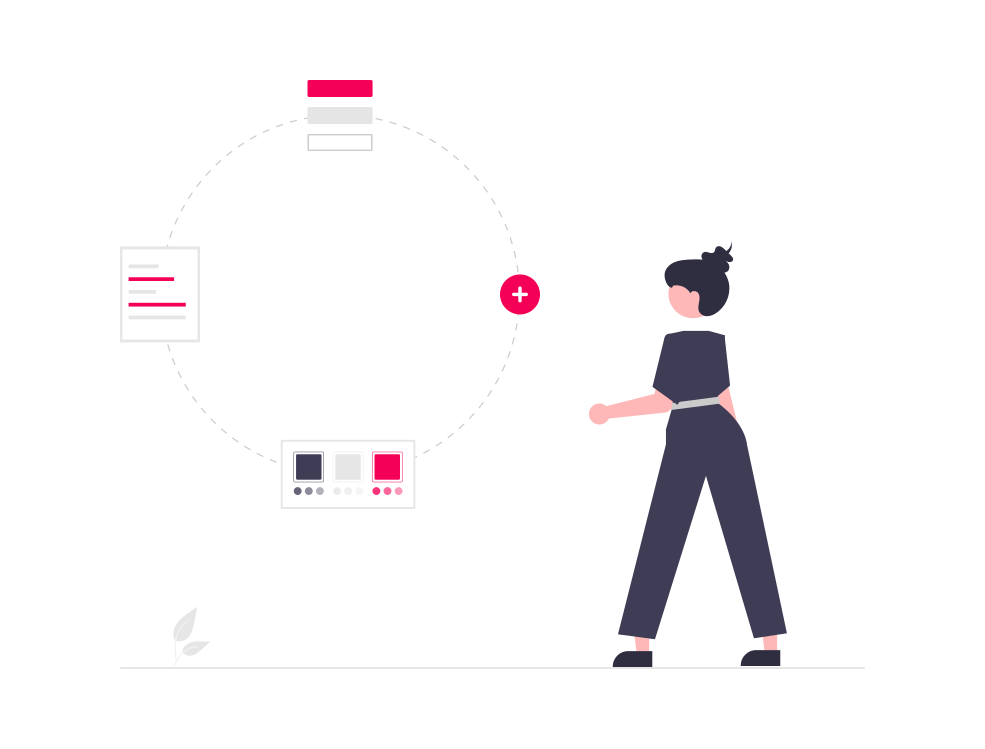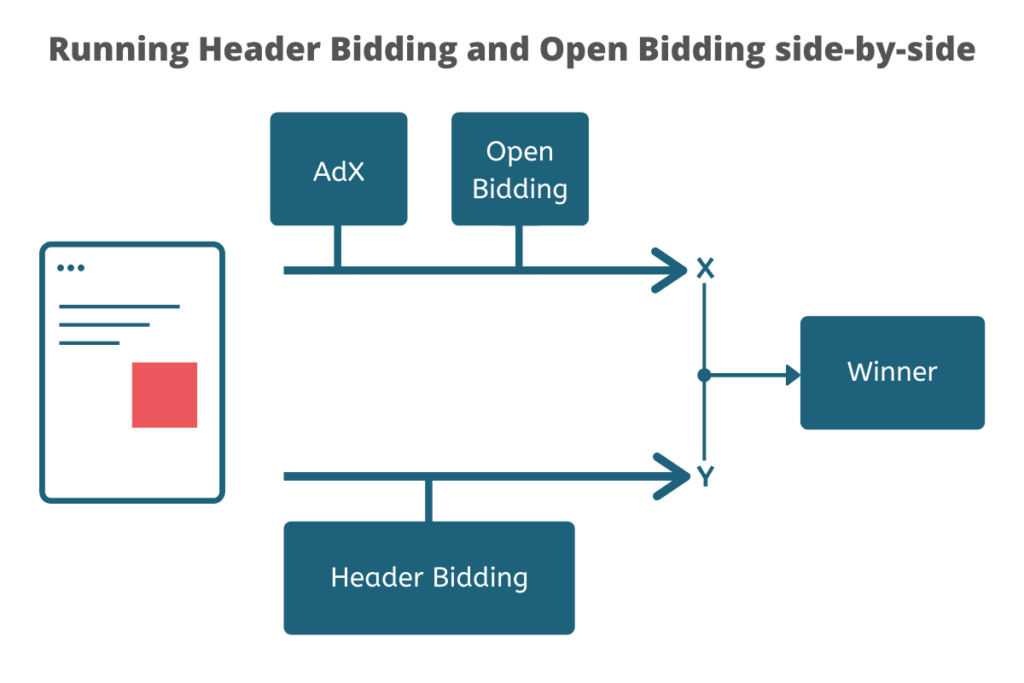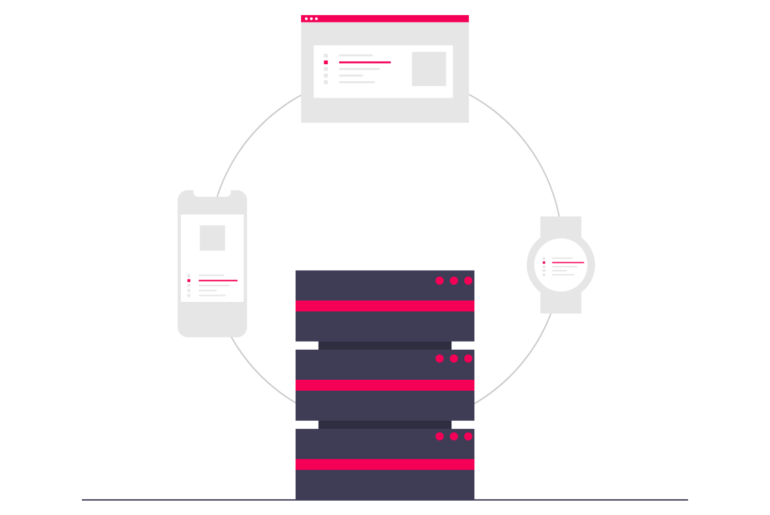Client-side header bidding vs server-side header bidding: Both techniques take the publisher’s inventory to demand partners. Then, how’re they different?
Header bidding was introduced for publishers to reach out to more buyers and maximize yield. It served well for that matter, however, it came with its own challenges (page latency and browser limitations).
Due to these challenges, it became necessary to have a process dealing with its drawbacks. Hence, server-side header bidding was introduced. But, that’s not perfect, either. Then, came client-side header bidding. Now, before we go deep into client-side vs server-side header bidding, let’s go through a quick recap.
Client-side vs Server-side Header Bidding?
What is Client-Side?
The phrase “client side” refers to anything on the web that is shown or occurs on the client device is called client-side. This includes text, graphics, user interface (UI), and any operations an application carries out inside the user’s browser.
The client side is where processes take place. It can be referred to as the frontend, although these two terms are not interchangeable. Client-side only refers to the location where processes occur, while frontend refers to the type of processes that happen on the client side.
What is Server-Side?
Everything that takes place on the server, as opposed to the client, is referred to as being “server side.” Historically, all business logic—including operations like displaying dynamic websites, communicating with databases, identity authentication, and push notifications—was carried out on the server.
The types of these processes are called backend. Backend refers to the server-side operations, whereas server-side refers to the area where these operations take place. The backend just describes the kinds of server-side processes, whereas server side describes the location of these processes.
So this was all you needed to know about client-side vs server-side differences. That said, let’s talk about client-side vs server-side header bidding.
What is Client-side Header Bidding?
Client-side header bidding (A.K.A. browser-side header bidding or header bidding) is a process where publishers take the inventory to multiple demand partners as soon as an impression becomes available.
Every time an impression is available, ad requests are sent to demand partners to place their bids.
After that, the bids are compared with the floor price (set by the publisher). The highest bid is selected and the winning bidder gets to display the ad.
This entire auction is conducted on a user’s browser. The process requires a header bidding wrapper that goes into a web page’s head code and the publisher gets to select the number of demand sources to plug into the wrapper.
What is Server-side Header Bidding?
Server-side header bidding, also known as server-to-server header bidding, is a technique when the auction takes place on a server instead of the user’s browser.
This was introduced to counter the page latency problem that prevails in client-side header bidding. Once an impression is available, a single ad request is sent to the server from the browser.
The server picks the request and calls demand partners to execute the auction. Once the bid is sold, the ad is displayed without affecting the page load time.
Now that you have a clear understanding of client-side vs server-side header bidding, let’s talk about why should you rely on client-side header bidding.

Why Choose Client-side Header Bidding Over Server-side Header Bidding?
- Publisher’s Control
With header bidding, publishers get to choose the buyers using the header bidding wrappers. Furthermore, floor price of each ad unit is decided by publishers. Consequently, the entire auction process becomes transparent for publishers and advertisers.
However, server-side doesn’t offer such transparency for publishers. Surely, floor price is decided by publishers, but they don’t see buyers participating in the auction and the auction process remains hidden. - Auction management:
The first reason why you should choose client-side header bidding over server-side header bidding is auction management.
Header bidding wrappers allow publishers to control and manage the auction. Using the wrappers, publishers add buyers, set up time-out settings, and make sure all buyers get the bid requests simultaneously.
On the other hand, with server-side header bidding, server reaches out to buyers and sends them bid requests, hence, managed by server.
In short, with server-side, most management tasks remain in the hands of server than publishers. - Cookie matching:
With client-side header bidding, advertisers access the ad units directly from publishers web pages using the wrapper which gives access to user’s cookie data.
This can further be used for ad targeting. Whereas, server-side header bidding lacks cookies matching. This is because most user data is filtered while syncing the publisher’s and server’s DMP. - Interested buyers:
Client-side header bidding is still preferred by most publishers and advertisers. This might be because of the transparency factor. Server-side header bidding is still too young to be accepted by ad industry.
Now that we’ve covered the pros client-side vs. server-side header bidding, let’s look at why server-side header bidding is preferable.
Why Choose Server-side Header Bidding Over Client-side Header Bidding?
Reduced Latency
As mentioned above, server-side header bidding is carried out in a server instead of a browser which reduces the page load time. Although latency time varies by a few milliseconds when compared with client-side header bidding, publishers still take page latency seriously as it affects the overall user experience.
Access as many demand partners
With server-side header bidding, server sends bid request to as many buyers the publishers want. This increases competition and offers a better ad fill rate. However, client-side header bidding is not that flexible as publishers choose just the required number of buyers to make sure impression is sold before auction timeout.
Perfect for video header bidding
Videos are rich media files and hence take more time to load on web pages than other ad formats. It’s clear by now that client-side header bidding increases page latency. And adding this to fact, videos are slow to load, can cause serious damage to user experience when used with client-side. However, server-side doesn’t pose such complications and works perfectly for video header bidding.
No browser request limitation
Web browsers have a limit to number of requests they can generate. As client-side header bidding takes place on the browser, publishers have a limited number of ad requests they can send via a browser during a session. Although server-side header bidding remains unaffected from such problems because of it doesn’t depend on browser to generate and send ad requests, rather ad server takes care of this.
What About Google Open Bidding (EBDA)?
Now that we have discussed client-side vs server-side programming and what factors you should consider when making your decision, let’s shift our focus to Google Open Bidding.
Looking at the tug-of-war between the client-side header bidding and server-side header bidding, Google launched EBDA (Exchange Bidding Dynamic Allocation, now Open Bidding) and called it Google’s header bidding. It’s known to solve page latency problems and offers Google support.
Open Bidding is as good as server-side header bidding. But it’s not available to every publisher. To get access, you need to be partners with Google Certified Publishing Partners.
Google deals in Net-30 whereas most demand partners go for Net-45, -60, and -90 cycles. As the revenue cycle doesn’t line up, this discourages demand partners to choose Open Bidding. Hence, Open Bidding leads to comparatively low demand and reduced competition on inventory.
To access Google’s demand, sellers and buyers have to get into a contractual relationship with Google. This takes time and adds more steps to the inventory-selling process. Not to forget, publishers would have to share a part of their earnings with Google. Whereas with header bidding, publishers would be getting dollars directly from demand.
Also, Google manages and controls the process for publishers causing transparency issues. On the plus side, publishers can get the benefits of header bidding without doing the leg work as Google manages everything for them (even the payments).
So, What Should You Choose?
It depends on you (publishers); also, your inventory type, demand, and market trends. As you can see, each of these header bidding processes has its own pros and cons. Hence, choosing one blindly is never recommended.
Ideally, a publisher should test them first and compare the results. The data generated by the results will give you the answer to your question‒which is better, client-side header bidding or server-side header bidding?
Alternatively, try Hybrid Header Bidding. The hybrid method allows publishers to run client-side and server-side auctions, together. Using Google Ad Exchange, publishers can make Google’s demand and header bidding compete for an impression.
Here’s how it works:

Once an impression is available, ad requests are sent to Google AdX and header bidding. Within the AdX system, both AdX and Open Bidding buyers place their bids to win the impression. Meanwhile, header bidding starts collecting bid responses from its demand partners. Upon completion, AdX and Open Bidding pass on a buyer(X). Similarly, header bidding passes on another (Y). Finally, AdX compares these bids and chooses the winner (highest bid).
This solves the issue of lack of demand as AdX and header bidding is now involved along with their buyers. To sum up, Hybrid Header Bidding means more demand, improved bids, and more revenue for publishers.
AdPushup Header Bidding Solution
Merely deploying header bidding in your ad stack isn’t enough. Consistently optimizing it with technical improvements is the need of the hour. This is what AdPushup’s header bidding solution does. Through our multiple optimization features using data science and machine learning, we help publishers maximize their yield.
With our header bidding solution, you get:
- Automatic demand partner selection according to optimum requirements
- Smart timeout management
- Freedom to bring your own demand
- Bid monitoring and discrepancy resolution
Read more about our product capability: Header Bidding
Final Words
In the current digital advertising landscape, both client-side header bidding and server-side header bidding offer advertisers an efficient way to bid and publishers a more effective way to maximize revenue. We hope by now you have thoroughly understood client-side vs server-side header bidding.
FAQs
Client-side header bidding uses a limited number of browser ports to send and receive information. Publishers could be denied access to the best bids if they request more partners than the available ports can accommodate.
S2S header bidding (also called server-side header bidding) is a programmatic technique in which the auction takes place on the ad server instead of the user’s browser. Your website can simultaneously work with multiple demand partners without compromising page speed.
With Open Bidding, you can invite third-party demand partners to bid on your inventory in a real-time, server-to-server auction. Trafficking, reporting, and billing are also simplified with Open Bidding in Ad Manager.
Client-side and server-side refers to whether the processing of a program is performed by the user’s computer or by the web server.
Client-side processing of a web page heavily relies on JavaScript and other browser-based technologies. This can be contrasted with server-side processing, which relies on the webserver to execute a program stored on the web server.
For example, in an online auction website that uses Javascript, the user’s web browser will send information about an auction to the web server. The web server will then run the client-side auction program, and return a web page to the user’s web browser with the results of the auction.
Client-side programming is especially useful in situations where the same program would need to be run many times on many different items (such as bids in an auction).
Server-side processing, on the other hand, is much more useful in situations where only one program (or a small set of related programs) would need to be run.
In the basic sense, server-side refers to the server computing code and delivering it, while client-side refers to the client computing code and delivering it.
If a website is delivered in its entirety from the server, then the server side is faster. If it’s delivered in part from the server and part from the client, then the client side is faster.
It also depends on the application, but client-side processing is generally faster. However, it has limitations: if the processor has a limited amount of memory or processing power, or if you are processing a large amount of data, server-side processing can be a better choice.

Shubham is a digital marketer with rich experience working in the advertisement technology industry. He has vast experience in the programmatic industry, driving business strategy and scaling functions including but not limited to growth and marketing, Operations, process optimization, and Sales.







